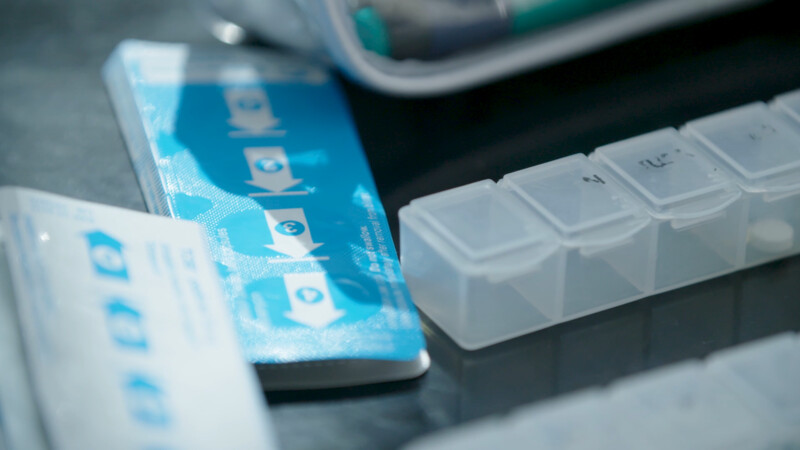Cystic fibrosis is caused by mutations in the cystic fibrosis transmembrane conductance regulator (CFTR) gene that affect the production of the CFTR protein. When the CFTR protein is not made correctly — or isn't made at all — the balance of salt and fluids inside and outside of the cell is disrupted. The resulting imbalance leads to thick, sticky mucus in the lungs, pancreas, and other organs.
We support the development of drugs that target specific defects in the CFTR protein. As a group, these drugs are called modulators because they are intended to modulate the function of the CFTR protein so that it can serve its primary function: to create a channel for chloride (a component of salt) to flow across the cell surface. Unfortunately, some people with CF have mutations that prevent the production of CFTR protein. Therefore, modulators will not work for them as there has to be a CFTR protein to modulate. We are pursuing the development of genetic therapies to help provide treatments for these people with CF.
When proper chloride flow is reestablished across the cell surface, mucus becomes rehydrated inside the lungs and other organs. Although modulators can't yet completely restore proper chloride flow, they can improve the flow enough to relieve symptoms for people with CF.
There are two main types of CFTR modulators:
- Potentiators
- Correctors
Potentiators
The CFTR protein is shaped like a tunnel that can be closed by a gate. Potentiators are CFTR modulators that hold the gate open so chloride can flow through the cell membrane.
The drug ivacaftor (Kalydeco) is a potentiator. This modulator can help patients with gating and conduction mutations. Ivacaftor also works on residual function and splice mutations where an insufficient amount of normal protein is present. In all these mutations, some CFTR protein reaches the surface of the cell. However, either not enough protein reaches the cell surface, or the protein does not allow enough chloride to flow through the cell membrane. By holding the gate on the CFTR protein open, potentiators allow more chloride to flow through and reduce the symptoms of CF.
Correctors
The next type of CFTR modulator is called a “corrector.” Correctors help the CFTR protein form the right 3-D shape so that it is able to move — or traffic — to the cell surface.
About 85 percent of people with CF in the Patient Registry have at least one copy of the F508del mutation, which prevents the CFTR protein from folding into the right shape. Corrector drugs help the CFTR protein form the right shape, traffic to the cell surface, and stay there longer; however, the correctors aren't able to completely fix the folding problem in the CFTR protein. For this reason, only some of the CFTR protein reaches the cell surface. Additionally, the proteins that do reach the cell surface do not open sufficiently to allow chloride to pass out of the cell.
But, if a corrector(s) is used in combination with a potentiator — such as ivacaftor — to hold the gate on the CFTR protein open, enough chloride can then flow to reduce the symptoms of CF.
The newest modulators — Trikafta and Alyftrek — are triple-combination therapies. They combine two correctors with one potentiator, enabling the modulator to work better than the dual-combination modulators (Orkambi and Symdeko).
Next-Generation Modulators
Researchers already are testing the next generation of modulators to find more effective ones and provide alternatives for people with CF who cannot tolerate currently approved modulators. Some of the novel drug compounds that are currently in clinical trials target defective parts of the CFTR protein that have proven to be difficult to fix.
Some compounds target nucleotide-binding domain 1 (NBD1), a region of the protein where the F508del mutation occurs. Others aim to correct the intracellular loop 4, or ICL4. No modulator currently on the market targets these areas.
Researchers hope to combine some of these compounds into a new triple-combination modulator therapy. Because this type of modulator therapy has the potential to correct the F508del mutation more fully, the Foundation has been supporting the development of this type of modulator therapy for more than a decade.
***
Reference to any specific product, process, or service does not necessarily constitute or imply its endorsement, recommendation, or favoring by the Cystic Fibrosis Foundation. The appearance of external hyperlinks does not constitute endorsement by the Cystic Fibrosis Foundation of the linked websites, or information, products, or services contained therein.
Information contained on this site does not cover all possible uses, actions, precautions, side effects, or interactions. This site is not intended as a substitute for treatment advice from a medical professional. Consult your doctor before making any changes to your treatment.
FDA-approved drug information is available at dailymed.nlm.nih.gov/dailymed.
